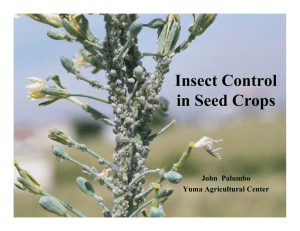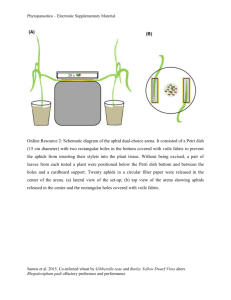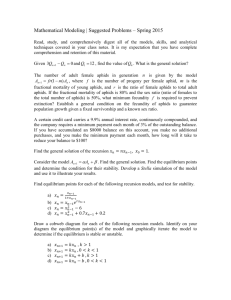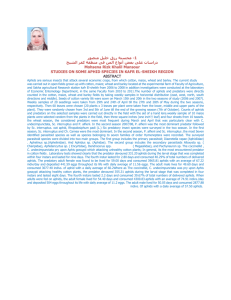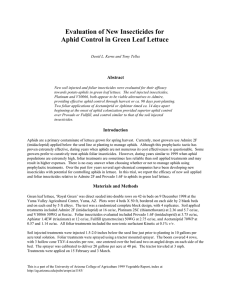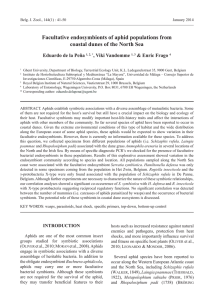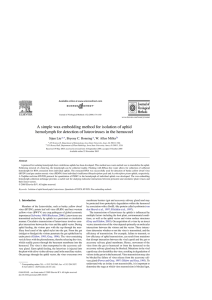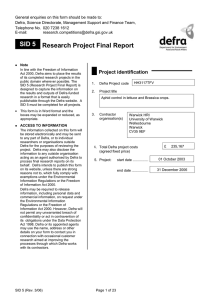Aphid Control in Broccoli Abstract
advertisement
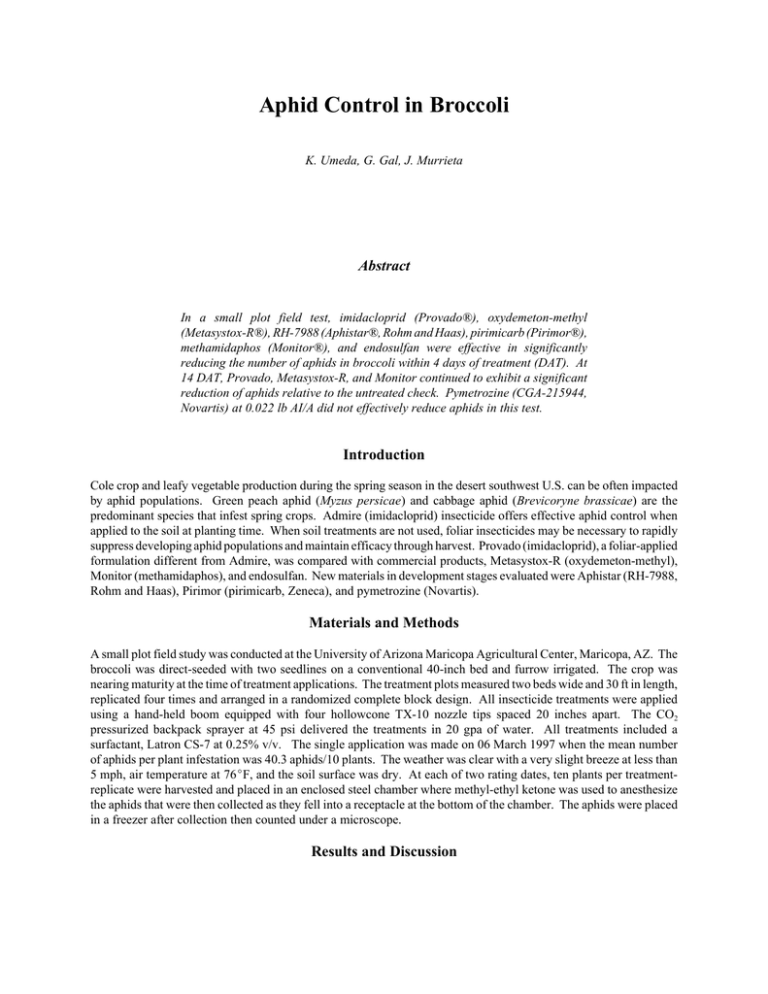
Aphid Control in Broccoli K. Umeda, G. Gal, J. Murrieta Abstract In a small plot field test, imidacloprid (Provado®), oxydemeton-methyl (Metasystox-R®), RH-7988 (Aphistar®, Rohm and Haas), pirimicarb (Pirimor®), methamidaphos (Monitor®), and endosulfan were effective in significantly reducing the number of aphids in broccoli within 4 days of treatment (DAT). At 14 DAT, Provado, Metasystox-R, and Monitor continued to exhibit a significant reduction of aphids relative to the untreated check. Pymetrozine (CGA-215944, Novartis) at 0.022 lb AI/A did not effectively reduce aphids in this test. Introduction Cole crop and leafy vegetable production during the spring season in the desert southwest U.S. can be often impacted by aphid populations. Green peach aphid (Myzus persicae) and cabbage aphid (Brevicoryne brassicae) are the predominant species that infest spring crops. Admire (imidacloprid) insecticide offers effective aphid control when applied to the soil at planting time. When soil treatments are not used, foliar insecticides may be necessary to rapidly suppress developing aphid populations and maintain efficacy through harvest. Provado (imidacloprid), a foliar-applied formulation different from Admire, was compared with commercial products, Metasystox-R (oxydemeton-methyl), Monitor (methamidaphos), and endosulfan. New materials in development stages evaluated were Aphistar (RH-7988, Rohm and Haas), Pirimor (pirimicarb, Zeneca), and pymetrozine (Novartis). Materials and Methods A small plot field study was conducted at the University of Arizona Maricopa Agricultural Center, Maricopa, AZ. The broccoli was direct-seeded with two seedlines on a conventional 40-inch bed and furrow irrigated. The crop was nearing maturity at the time of treatment applications. The treatment plots measured two beds wide and 30 ft in length, replicated four times and arranged in a randomized complete block design. All insecticide treatments were applied using a hand-held boom equipped with four hollowcone TX-10 nozzle tips spaced 20 inches apart. The CO2 pressurized backpack sprayer at 45 psi delivered the treatments in 20 gpa of water. All treatments included a surfactant, Latron CS-7 at 0.25% v/v. The single application was made on 06 March 1997 when the mean number of aphids per plant infestation was 40.3 aphids/10 plants. The weather was clear with a very slight breeze at less than 5 mph, air temperature at 76EF, and the soil surface was dry. At each of two rating dates, ten plants per treatmentreplicate were harvested and placed in an enclosed steel chamber where methyl-ethyl ketone was used to anesthesize the aphids that were then collected as they fell into a receptacle at the bottom of the chamber. The aphids were placed in a freezer after collection then counted under a microscope. Results and Discussion The aphid species predominant in the broccoli was cabbage aphid. Rating dates at 4 and 14 DAT, showed that Provado treated broccoli had the fewest number of aphids with 14.5 and 78.0 aphids per 10 plants (Table), respectively. Metasystox-R and Monitor, two commercially available products, performed similarly to Provado with broccoli having significantly reduced numbers of aphids compared to the untreated check. At 4 DAT, Aphistar, Pirimor, and endosulfan were effective in significantly reducing aphids compared to the untreated check and also similar to Metasystox-R and Monitor. At 14 DAT, Aphistar, Pirimor, and endosulfan had fewer aphids than the untreated check but did not differ significantly. CGA-215944, at the rate tested, did not offer adequate efficacy against the aphids in this test. All treatments, except CGA-215944, were highly effective in reducing numbers of aphids relatively quickly at 4 DAT. Significant extended control was observed in broccoli treated by the commercial products, Provado, Metasystox-R, and Monitor. Aphistar, Pirimor, and endosulfan were intermediate in exhibiting slightly less activity immediately after application and not offering long-term control. Aphid control is possible to achieve with commercial insecticides. New materials in development stages offer the potential to be integrated into pest management strategies. Earlier timing of applications soon after detection of aphids could make insecticides more efficacious in commercial growing situations. Multiple applications or alternating insecticides could offer more efficacious long-term control. Foliar aphid insecticide treatments could complement the use of soil-applied insecticides. Table. Aphid Control in Broccoli, 1997. (Umeda, Gal, Murrieta) Treatment Untreated Check Provado Metasystox-R Aphistar Pirimor Pymetrozine Monitor Endosulfan Rate (lb AI/A) Mean No. Aphids/10 plants 06-Mar 10-Mar 20-Mar 40.3 0.047 0.5 0.1 0.25 0.022 0.75 0.75 LSD (p=0.05) Treatments applied on 06 Mar 1997. 221.8 14.5 49.0 52.5 117.3 203.3 74.3 125.5 239.0 78.0 117.0 186.3 121.0 343.3 107.0 152.7 87.8 110.1

